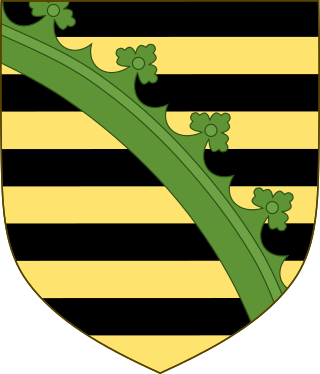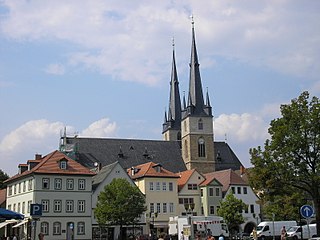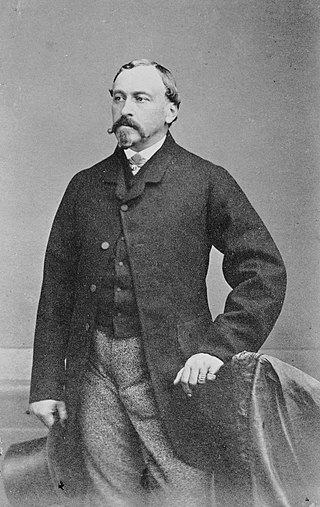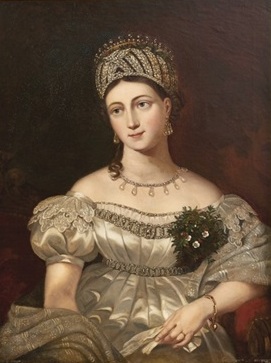
Prince Albert of Saxe-Coburg and Gotha was the husband of Queen Victoria. As such, he was consort of the British monarch from their marriage on 10 February 1840, until his death in 1861. He received the unique title of Prince Consort in 1857 from his wife.

Saxe-Coburg and Gotha, or Saxe-Coburg-Gotha, was an Ernestine duchy in Thuringia ruled by a branch of the House of Wettin, consisting of territories in the present-day states of Thuringia and Bavaria in Germany. It lasted from 1826 to 1918. In November 1918, Charles Edward, Duke of Saxe-Coburg and Gotha, was forced to abdicate. In 1920, the northern part of the duchy was merged with six other Thuringian free states to form the Free State of Thuringia: Saxe-Weimar-Eisenach, Saxe-Altenburg and Saxe-Meiningen, Schwarzburg-Rudolstadt and Schwarzburg-Sondershausen, as well as the People's State of Reuss. The southern part of the duchy, as southernmost of the Thuringian states, was the only one which, after a referendum, became part of the Free State of Bavaria.

Augusta of Reuss-Ebersdorf, was by marriage the Duchess of Saxe-Coburg-Saalfeld. She was the grandmother and godmother of both Queen Victoria of the United Kingdom and her husband and cousin, Prince Albert of Saxe-Coburg and Gotha.

The House of Wettin was a dynasty of German kings, prince-electors, dukes, and counts that once ruled territories in the present-day German states of Saxony, Saxony-Anhalt and Thuringia. The dynasty is one of the oldest in Europe, and its origins can be traced back to the town of Wettin, Saxony-Anhalt. The Wettins gradually rose to power within the Holy Roman Empire. Members of the family became the rulers of several medieval states, starting with the Saxon Eastern March in 1030. Other states they gained were Meissen in 1089, Thuringia in 1263, and Saxony in 1423. These areas cover large parts of Central Germany as a cultural area of Germany.

Saalfeld is a town in Germany, capital of the Saalfeld-Rudolstadt district of Thuringia. It is best known internationally as the ancestral seat of the Saxe-Coburg and Gotha branch of the Saxon House of Wettin.

Ernest II was Duke of Saxe-Coburg and Gotha from 29 January 1844 to his death in 1893. He was born in Coburg to Ernest III, Duke of Saxe-Coburg-Saalfeld, and Princess Louise of Saxe-Gotha-Altenburg. His father became Duke of Saxe-Coburg and Gotha in 1826 through an exchange of territories.

Coburg is a town located on the Itz river in the Upper Franconia region of Bavaria, Germany. Long part of one of the Thuringian states of the Wettin line, it joined Bavaria by popular vote only in 1920. Until the revolution of 1918, it was one of the capitals of the Duchy of Saxe-Coburg and Gotha and the Duchy of Saxe-Coburg-Saalfeld.

Louise of Saxe-Gotha-Altenburg ; was the wife of Ernst I, Duke of Saxe-Coburg and Gotha and the mother of Duke Ernst II and Prince Albert, husband of Queen Victoria.

Princess Sibylla of Saxe-Coburg and Gotha was a member of the Swedish royal family and the mother of the current king of Sweden, Carl XVI Gustaf.

Saxe-Coburg-Saalfeld was one of the Saxon Duchies held by the Ernestine line of the Wettin Dynasty. Established in 1699, the Saxe-Coburg-Saalfield line lasted until the reshuffle of the Ernestine territories that occurred following the extinction of the Saxe-Gotha line in 1825, in which the Saxe-Coburg-Saalfeld line received Gotha, but lost Saalfeld to Saxe-Meiningen.

The Ernestine duchies, also known as the Saxon duchies, were a group of small states whose number varied, which were largely located in the present-day German state of Thuringia and governed by dukes of the Ernestine line of the House of Wettin.

Louise of Saxe-Gotha-Altenburg was Duchess consort of Mecklenburg-Schwerin through her marriage to Frederick Francis I, Grand Duke of Mecklenburg, Louise was also a member of the House of Mecklenburg.

Schloss Rosenau, called in English The Rosenau or Rosenau Palace, is a former castle, converted into a ducal country house, near the town of Rödental, formerly in Saxe-Coburg, now lying in Bavaria, Germany.
Events from the year 1873 in Germany.
Events in the year 1910 in Germany.
Events in the year 1890 in Germany.
Events in the year 1874 in Germany.
Events in the year 1877 in Germany.

Victoria, Queen of the United Kingdom of Great Britain and Ireland and Empress of India, died on 22 January 1901 at Osborne House on the Isle of Wight, at the age of 81. At the time of her death, she was the longest-reigning monarch in British history. Her state funeral took place on 2 February 1901, being one of the largest gatherings of European royalty.
Events from the year 1826 in Germany













